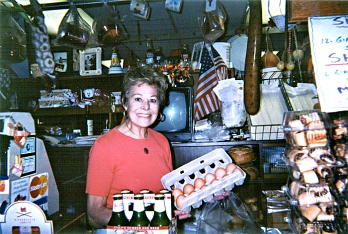
Ursula Vera is seen behind the counter at Sorrento Italian Market in Culver City holding a carton of eggs from a ranch owned by her husband and her.
Thursday, November 13, 2003
Page 15
REMINISCING (Column)
Do You Remember the Taste of Farm-Fresh Eggs?
By ROGER M. GRACE
How long has it been since you’ve had a fresh egg?
No, I don’t mean an egg in a carton with an expiration date that hasn’t been reached yet. I mean an egg that was laid in, say, the past two or three days.
If you taste such an egg, you’ll readily discern the difference between it and what you can buy at Ralph’s.
It will, if you’re old enough to remember the days when the milkman brought eggs fresh from the country, evoke a memory of a taste you probably haven’t encountered in a good many years.
So where does one procure a fresh egg these days? I’ve found one place: an Italian market in Culver City. After all, where else would you go for eggs other than to an Italian market?
I’m referring to Sorrento Italian Market, at 5518 S. Sepulveda Boulevard. It’s owned and run by Culver City Councilman Albert M. Vera (a two-time mayor) and his wife of 40 years, Ursula Vera. The eggs (as well as the fresh vegetables they sell) are from their farms in Tulare County.
|
|
Ursula Vera is seen behind the counter at Sorrento Italian Market in Culver City holding a carton of eggs from a ranch owned by her husband and her. |
|
The eggs are sold for $1.98 a dozen—when they’re in stock. On a recent trip there, we went away with mortadella and salamis but, alas, no eggs. More would be gathered the next day.
Albert Vera, his wife advises, goes to the farm three times a week—except during the picking season, when he stays there.
If you crack open an egg from a supermarket, you’ll see a bright yellow yoke. The Veras’ eggs have orange yokes. The reason is simple. Commercial producers of eggs feed their chickens a dye called Yellow 5.
As I mentioned last week, the same group that led the successful effort to ban Red 2, a carcinogenic, is currently urging that Yellow 5 be outlawed.
What’s ahead for the egg?
Well, surely there’s no movement toward getting eggs to the consumer faster. The trend is, rather, to extend the shelf life of eggs.
Pasteurized liquid eggs have been on the market since 1996. The pasteurization is achieved through repeated immersions of de-shelled eggs in hot water, not getting them hot enough to cook them, but hot enough to kill germs.
Now there are pasteurized eggs in the shell, sold in cartons beside conventional eggs. Von’s sells them with the motto, “Pasteurized, for your peace of mind.”
These pre-heated eggs are said to last up to six months. The Veras can’t claim that as to the eggs they sell. But somehow, the idea of eating an egg that was laid a half year back doesn’t strike me as appetizing.
On July 21, 2000, the Food and Drug Administration published a final rule authorizing ionizing radiation of eggs. Over the preceding years, various other foods had also been approved for radiation blasts. The FDA explained in a January, 2000 brochure:
“During irradiation, foods are exposed briefly to a radiant energy source such as gamma rays or electron beams within a shielded facility. Irradiation is not a substitute for proper food manufacturing and handling procedures. But the process, especially when used to treat meat and poultry products, can kill harmful bacteria, greatly reducing potential hazards.”
Not all segments of the scientific community are convinced of the safety of bombarding food with electrons moving at the speed of light. Dr. Joseph Marcolas, an osteopathic physician who has written numerous articles for medical journals, for one, has cautioned:
“In the course of legalizing the irradiation of beef, chicken, pork, fruit, vegetables, eggs, juice, spices and sprouting seeds—a process that has spanned nearly 20 years—the U.S. Food and Drug Administration has dismissed or ignored a substantial body of evidence suggesting that irradiated food may not be safe for human consumption.”
What about the effect on the flavor of the egg?
A recent Washington State Department Of Health position paper, while endorsing food irradiation, in general, commented:
“Food irradiation cannot be used to treat dairy foods or eggs because of resulting adverse flavors.”
In his book “Food Irradiation,” published by the Academic Press in 1986, Walter M. Urbain, professor emeritus of Michigan State University, said that irradiation of food results in a taste that “resembles a scorched flavour.” Urbain (who died last year at 91) added that such “off flavors” are most apt to be found in eggs or dairy products.
While Gabby Hayes in the early 1950s touted a cereal that was “shot from guns,” I just can’t see an appeal to foods shot with rays.
So, come what may on the market—eggs that are ionized, vaccinated, salted in the shell, injected with cheese particles, or dehydrated and stuck in capsules for those who don’t like the taste of eggs—my wife and I are going to keep getting our eggs at Sorrento. When they have them.
Copyright 2003, Metropolitan News Company